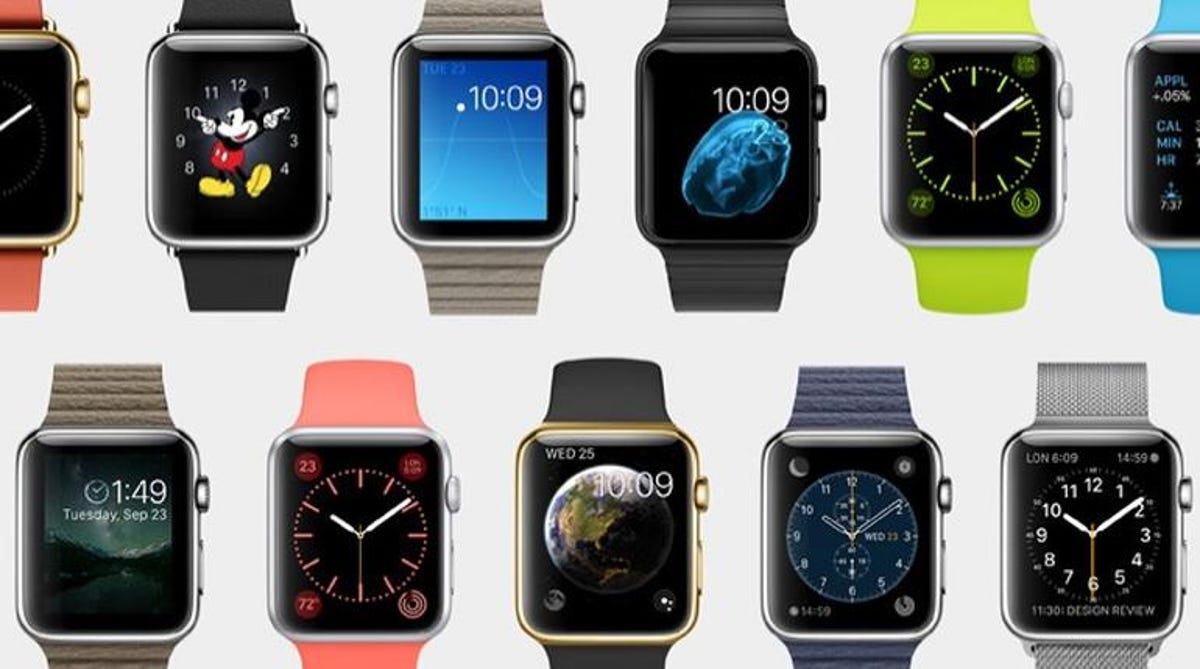
Apple
If there’s a new fight looming between Apple and Google for the attention of smartwatch app developers, the developers themselves aren’t tipping their hands.
There’s a lot about the new Apple Watch that lends itself to a techie slapfest. The long-rumored touch-screen watch, which debuted at a media event in Cupertino, Calif., on Tuesday, is expected to come in three lookalike models made from stainless steel, aluminum and 18-karat gold.
By comparison, Android Wear watches — much like Android phones and tablets themselves — come in a sprawling variety of shapes, sizes, and hardware specifications. Apps designed for circular Android Wear watches, such as the Moto 360, may not work on rectangular faced-devices like the LG G Watch. That potentially adds confusion for consumers, and work for developers.
Related stories
- With its debut smartwatch, Apple aims to make wearables fashionable
- Apple jumps into wearables fray with Apple Watch
- Editors’ take: Apple Watch
- Apple supersizes the iPhone 6, joins the big-screen era at last
- Editors’ take: iPhone 6 Plus
But it also adds choice. The overall popularity of Android, with its more than 80 percent marketshare and rising, and Apple’s higher-end products, proves that few developers want to lock themselves out of either ecosystem.
The most important thing, many developers said, is that they finally know the shape and scope, if not the specifics, of the Apple wearable.
“This is just validation of the category [of smartwatches],” said Mike Maser, the chief executive of FitStar, an iOS-only personal training exercise app. The Apple Watch, he said, “might not be the least expensive, it may be more elegant [than Android Wear watches], but whether you’re an Apple fan or an Android user, the use cases and accessibility of that data is exciting.”
But while smartwatches make more user data accessible to developers, there’s little indication that developers care much at this point which device ecosystem they’re building for as long as consumers are buying them.
Matt Runo, the Android Development Manager for Zappos, described Android Wear and Apple Watch as “add-ons.”
“It’s not going to necessarily change the game in terms of Android versus iOS,” he said. “I don’t think anyone’s going to say ‘WatchKit is amazing, I’m not going to develop for Google.'”
That’s not to say that developers aren’t excited for the Apple Watch. As Apple’s keynote was taking place, “our team was sitting around brainstorming ways to integrate with it,” said Maser.
For some developers, part of the problem is that while the Apple Watch appears to have struck a balance between ergonomics and digital design, it’s not definitively a more advanced product than what’s already available — at least in terms of sensor accuracy.
Liz Dickinson, the founder and chief executive of the health tracker maker Mio Global, said that the Apple Watch is “not earth shattering. You can get the same kind of information from our product or FitBit,” she said.
“It doesn’t really compete with our product,” Dickinson said, explaining that Mio’s products are “for serious exercisers.”
On that count, she may be right. The Mio tracks continuous heart rate, which the Apple Watch appears not to do. Neither does the Moto 360 or Samsung Galaxy Gear Live, which launched at Google I/O along with the LG watch. For people who need more precise data, either for medical or fitness reasons, these watches are more like the imprecise cuts of a steak knife when what’s needed is a surgeon’s scalpel.
One surgeon who’s also involved in building sensors into wearable technology is Dr. Jesse Slade Shantz, the Chief Medical Officer of OM Signal, which is making a sensor-laden shirt for biometrics-driven exercise. And yes, it comes with an iOS app, and is only on iOS — for now.
“They’re just putting this out there to facilitate apps,” he said. “Consumers are ready for this cool, show-and-tell kind of thing. There’s going to be a point that you have to move past that and give people real value.”
The importance of Apple’s announcement, Shantz said, is that now both Google and Apple take the nascent smartwatch market seriously. That creates a fertile cross-platform which nearly all smartphone developers can begin to hoe.
The challenge, he said, will be getting people who’ve abandoned “dumb” wrist-wear to reconsider them now that they’re getting a lot smarter. They’re not cheap, with $199 for the Samsung Gear Live, $249 for the Moto 360, $349 for the low-end Apple Watch.
Just because Apple and Google see dollar signs on every wrist out there doesn’t mean that people are willing to shell out hundreds, but developers can’t take that chance. If Google, and now Apple, make it, you can be sure that the developers will come.



